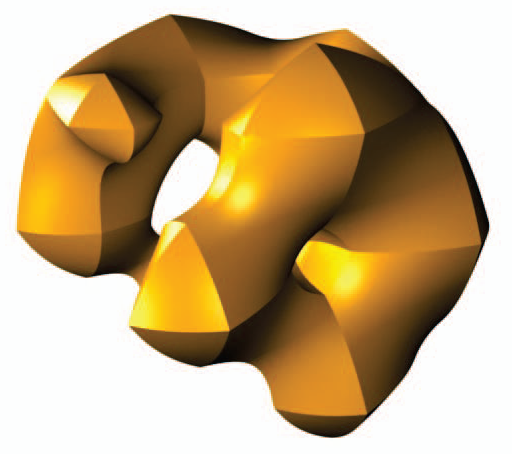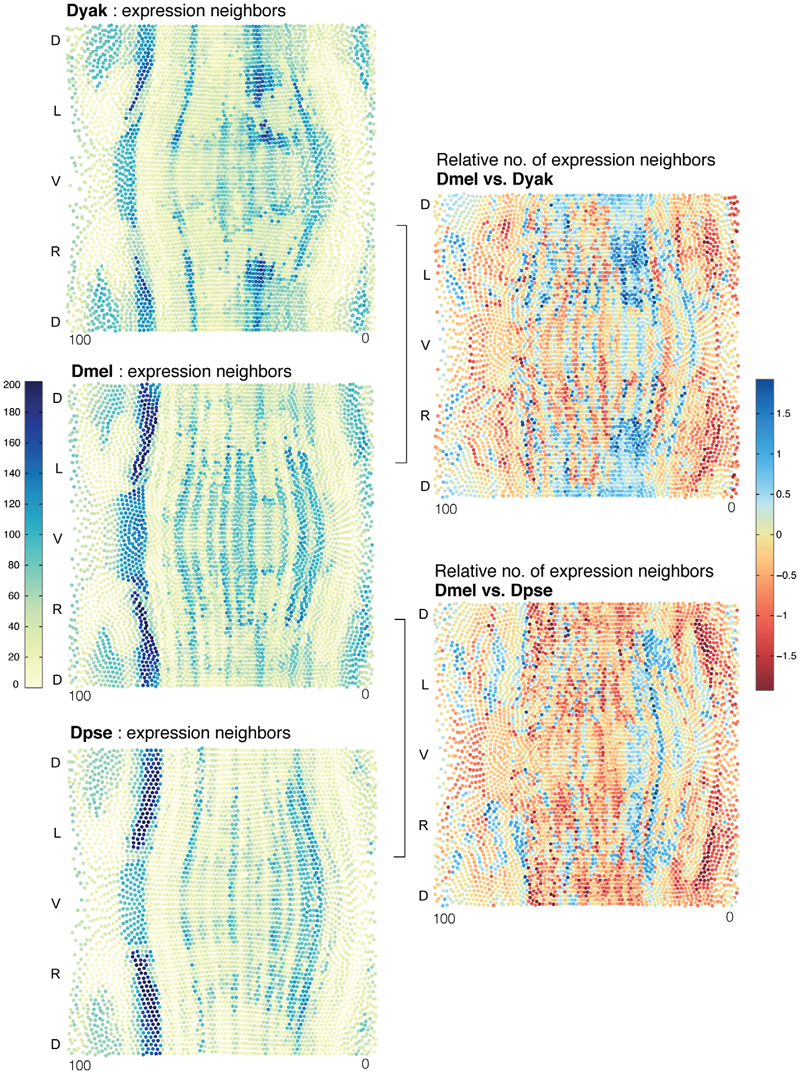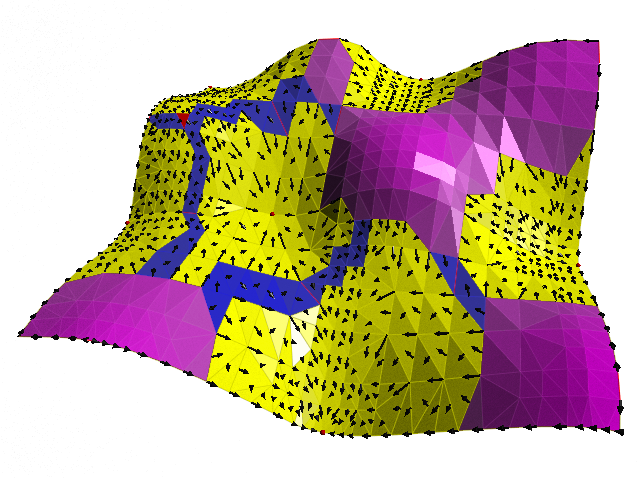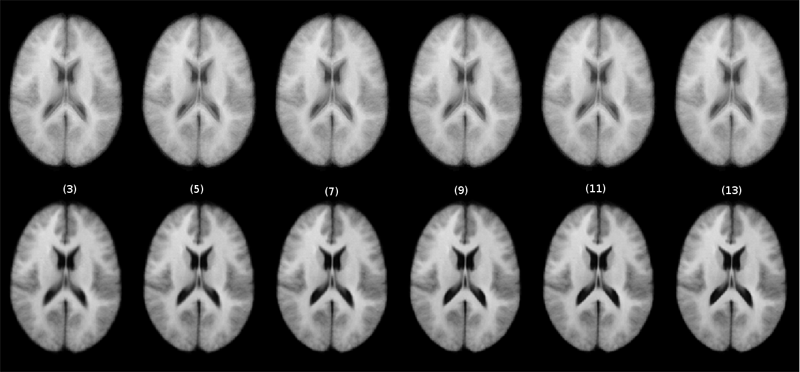SCI Publications
2011


B. Erem, P.M. van Dam, D.H. Brooks.
“Analysis of the Criteria of Activation-Based Inverse Electrocardiography using Convex Optimization,” In Conf Proc IEEE Eng Med Biol Soc, pp. 3913–3916. 2011.
DOI: 10.1109/IEMBS.2011.6090972
PubMed ID: 22255195
PubMed Central ID: PMC3359386
In inverse electrocardiography (ECG), the problem of finding activation times on the heart noninvasively from body surface potentials is typically formulated as a nonlinear least squares optimization problem. Current solutions rely on iterative algorithms which are sensitive to the presence of local minima. As a result, improved initialization approaches for this problem have been of considerable interest. However, in experiments conducted on a subject with Wolff-Parkinson-White syndrome, we have observed that there may be a mismatch between favorable solutions of the optimization problem and solutions with the desired physiological characteristics. In this work, we use a method based on a convex optimization framework to explore the solution space and analyze whether the optimization criteria target their intended objective.


B. Erem, D.H. Brooks.
“Differential Geometric Approximation of the Gradient and Hessian on a Triangulated Manifold,” In Proceeding of the IEEE International Symposium on Biomedical Imaging: from nano to macro, pp. 504--507. 2011.
DOI: 10.1109/ISBI.2011.5872455
PubMed ID: 21712967
PubMed Central ID: PMC3122924
In a number of medical imaging modalities, including measurements or estimates of electrical activity on cortical or cardiac surfaces, it is often useful to estimate spatial derivatives of data on curved anatomical surfaces represented by triangulated meshes. Assuming the triangle vertices are points on a smooth manifold, we derive a method for estimating gradients and Hessians on locally 2D surfaces embedded in 3D directly in the global coordinate system. Accuracy of the method is validated through simulations on both smooth and corrugated surfaces.


T. Etiene, L.G. Nonato, C. Scheidegger, J. Tierny, T.J. Peters, V. Pascucci, R.M. Kirby, C.T. Silva.
“Topology Verfication for Isosurface Extraction,” In IEEE Transactions on Visualization and Computer Graphics, pp. (accepted). 2011.
The broad goals of verifiable visualization rely on correct algorithmic implementations. We extend a framework for verification of isosurfacing implementations to check topological properties. Specifically, we use stratified Morse theory and digital topology to design algorithms which verify topological invariants. Our extended framework reveals unexpected behavior and coding mistakes in popular publicly-available isosurface codes.


J. Fishbaugh, S. Durrleman, G. Gerig.
“Estimation of Smooth Growth Trajectories with Controlled Acceleration from Time Series Shape Data,” In Lecture Notes in Computer Science, LNCS 6892, Springer, pp. 401--408. 2011.
DOI: 10.1007/978-3-642-23629-7_49
Longitudinal shape analysis often relies on the estimation of a realistic continuous growth scenario from data sparsely distributed in time. In this paper, we propose a new type of growth model parameterized by acceleration, whereas standard methods typically control the velocity. This mimics the behavior of biological tissue as a mechanical system driven by external forces. The growth trajectories are estimated as smooth flows of deformations, which are twice differentiable. This differs from piecewise geodesic regression, for which the velocity may be discontinuous. We evaluate our approach on a set of anatomical structures of the same subject, scanned 16 times between 4 and 8 years of age. We show our acceleration based method estimates smooth growth, demonstrating improved regularity compared to piecewise geodesic regression. Leave-several-out experiments show that our method is robust to missing observations, as well as being less sensitive to noise, and is therefore more likely to capture the underlying biological growth.
Keywords: na-mic


P.T. Fletcher.
“Geodesic Regression on Riemannian Manifolds,” In Proceedings of the Third MICCIA International Workshop on Mathematical Foundations of Computational Anatomy (MFCA), Toronto, Canada, pp. 75--86. 2011.


P.T. Fletcher, J. Moeller, J. Phillips, S. Venkatasubramanian.
“Horoball hulls and extents in positive definite space,” In Algorithms and Data Structures, Lecture Notes in Computer Science (LNCS), Vol. 6844/2011, pp. 386--398. 2011.
DOI: 10.1007/978-3-642-22300-6_33


T. Fogal, J. Krüger.
“Efficient I/O for Parallel Visualization,” In Proceedings of the Eurographics Symposium on Parallel Graphics and Visualization (2011), Edited by T. Kuhlen and R. Pajarola and K. Zhou, pp. 81--90. 2011.


C. Fowlkes, K. Eckenrode, M. Bragdon, M.D. Meyer, Z. Wunderlich, L. Simirenko, C. Luengo, S. Keranen, C. Henriquez, D. Knowles, M. Biggin, M. Eisen, A. DePace.
“A Conservered Developmental Patterning Network Produces Quantitatively Different Output in Multiple Species of Drosophila,” In PLoS Genetics, Vol. 7, No. 10:e1002346, pp. 17 pages. October, 2011.
Differences in the level, timing, or location of gene expression can contribute to alternative phenotypes at the molecular and organismal level. Understanding the origins of expression differences is complicated by the fact that organismal morphology and gene regulatory networks could potentially vary even between closely related species. To assess the scope of such changes, we used high-resolution imaging methods to measure mRNA expression in blastoderm embryos of Drosophila yakuba and Drosophila pseudoobscura and assembled these data into cellular resolution atlases, where expression levels for 13 genes in the segmentation network are averaged into species-specific, cellular resolution morphological frameworks. We demonstrate that the blastoderm embryos of these species differ in their morphology in terms of size, shape, and number of nuclei. We present an approach to compare cellular gene expression patterns between species, while accounting for varying embryo morphology, and apply it to our data and an equivalent dataset for Drosophila melanogaster. Our analysis reveals that all individual genes differ quantitatively in their spatio-temporal expression patterns between these species, primarily in terms of their relative position and dynamics. Despite many small quantitative differences, cellular gene expression profiles for the whole set of genes examined are largely similar. This suggests that cell types at this stage of development are conserved, though they can differ in their relative position by up to 3-4 cell widths and in their relative proportion between species by as much as 5-fold. Quantitative differences in the dynamics and relative level of a subset of genes between corresponding cell types may reflect altered regulatory functions between species. Our results emphasize that transcriptional networks can diverge over short evolutionary timescales and that even small changes can lead to distinct output in terms of the placement and number of equivalent cells.


Z. Fu, W.-K. Jeong, Y. Pan, R.M. Kirby, R.T. Whitaker.
“A fast iterative method for solving the Eikonal equation on triangulated surfaces,” In SIAM Journal of Scientific Computing, Vol. 33, No. 5, pp. 2468--2488. 2011.
DOI: 10.1137/100788951
PubMed Central ID: PMC3360588
This paper presents an efficient, fine-grained parallel algorithm for solving the Eikonal equation on triangular meshes. The Eikonal equation, and the broader class of Hamilton–Jacobi equations to which it belongs, have a wide range of applications from geometric optics and seismology to biological modeling and analysis of geometry and images. The ability to solve such equations accurately and efficiently provides new capabilities for exploring and visualizing parameter spaces and for solving inverse problems that rely on such equations in the forward model. Efficient solvers on state-of-the-art, parallel architectures require new algorithms that are not, in many cases, optimal, but are better suited to synchronous updates of the solution. In previous work [W. K. Jeong and R. T. Whitaker, SIAM J. Sci. Comput., 30 (2008), pp. 2512–2534], the authors proposed the fast iterative method (FIM) to efficiently solve the Eikonal equation on regular grids. In this paper we extend the fast iterative method to solve Eikonal equations efficiently on triangulated domains on the CPU and on parallel architectures, including graphics processors. We propose a new local update scheme that provides solutions of first-order accuracy for both architectures. We also propose a novel triangle-based update scheme and its corresponding data structure for efficient irregular data mapping to parallel single-instruction multiple-data (SIMD) processors. We provide detailed descriptions of the implementations on a single CPU, a multicore CPU with shared memory, and SIMD architectures with comparative results against state-of-the-art Eikonal solvers.


S.E. Geneser, J.D. Hinkle, R.M. Kirby, Bo Wang, B. Salter, S. Joshi.
“Quantifying variability in radiation dose due to respiratory-induced tumor motion,” In Medical Image Analysis, Vol. 15, No. 4, pp. 640--649. 2011.
DOI: 10.1016/j.media.2010.07.003


G. Gerig, I. Oguz, S. Gouttard, J. Lee, H. An, W. Lin, M. McMurray, K. Grewen, J. Johns, M.A. Styner.
“Synergy of image analysis for animal and human neuroimaging supports translational research on drug abuse,” In Frontiers in Child and Neurodevelopmental Psychiatry, Vol. 2, Edited by Linda Mayes, pp. 9 pages. 2011.
ISSN: 1664-0640
DOI: 10.3389/fpsyt.2011.00053


G. Gerig, J.H. Gilmore, W. Lin.
“Brain Maturation of Newborns and Infants,” Encyclopedia on Early Childhood Development (online): Brain Development in Children - According to Experts, Montreal, Quebec, Centre of Excellence for Early Childhood Development and Strategic Knowledge Cluster on Early Child Development, pp. 1--6. 2011.
Recently, imaging studies of early human development have received more attention, as improved modeling methods might lead to a clearer understanding of the origin, timing, and nature of differences in neurodevelopmental disorders. Non-invasive magnetic resonance imaging (MRI) can provide three-dimensional images of the infant brain in less than 20 minutes, with unprecedented anatomical details and contrast of brain anatomy, cortical and subcortical structures and brain connectivity. Repeating MRI at different stages of development, e.g., in yearly intervals starting after birth, gives scientists the opportunity to study the trajectory of brain growth and compare individual growth trajectories to normative models. These comparisons become highly relevant in personalized medicine, where early diagnosis is a critical juncture for timing and therapy types.


T. Geymayer, A. Lex, M. Streit, D. Schmalstieg.
“Visualizing the Effects of Logically Combined Filters,” In Proceedings of the Conference on Information Visualisation (IV '11), IEEE, pp. 47--52. 2011.
Filtering data is an essential process in a drill-down analysis of large data sets. Filtering can be necessary for several reasons. The main objective for filters is to uncover the relevant subsets of a dataset. Another, equally relevant goal is to reduce a dataset to dimensions to which either visualization or algorithmic analysis techniques scale. However, with multiple filters applied and possibly even logically combined, it becomes difficult for users to judge the effects of a filter chain. In this paper we present a simple, yet effective way to interactively visualize a sequence of filters and logical combinations of these. Such a visualized filter-pipeline allows analysts to easily judge the effect of every single filter and also their combination on the data set under investigation and therefore, leads to a faster and more efficient workflow.
We also present an implementation of the proposed technique in an information visualization framework for the life sciences. The technique, however, could be employed in many other information visualization contexts as well.


G. Gopalakrishnan, R.M. Kirby, S. Siegel, R. Thakur, W. Gropp, E. Lusk, B.R. de Supinski, M. Schultz, G. Bronevetsky.
“Formal Analysis of MPI-Based Parallel Programs: Present and Future,” In Communications of the ACM, pp. (accepted). 2011.


J. Grueninger, H. Hoffman, U. Kloos, J. Krüger.
“Multi-Resolution-Display System for Virtual Reality Setups,” In Proceedings of the 14th International Conference on Human-Computer Interaction, HCI International, Lecture Notes in Computer Science, Vol. 6779/2011, pp. 180--189. 2011.
DOI: 10.1007/978-3-642-21716-6_19
Most large-area video projection systems offer only limited spacial resolution. Consequently, images of detailed scenery cannot be displayed at full fidelity. A possible but significantly more costly strategy is a tiled projection display. If this solution is not feasible then either aliasing occurs or some anti-aliasing method is used at the cost of reduced scene quality.
In this paper we describe a novel cost effective multi-resolution display system. It allows users to select any part of a stereoscopic projection and view it in significantly higher resolution than possible with the standard projection alone. To achieve this, a pair of video projectors, which can be moved by stepper motors, project a high-resolution inset into a small portion of the low-resolution image. To avoid crosstalk between the low and high resolution projections, a mask is rendered into the low resolution scene to black out the area on the screen that is covered by the inlay.
To demonstrate the effectiveness of our multi-resolution display setup it has been integrated into a number of real life scenarios: a virtual factory, an airplane cabin simulation, and a focus and context volume visualization application (see Figure 1).


Attila Gyulassy, J.A. Levine, V. Pascucci.
“Visualization of Discrete Gradient Construction (Multimedia submission),” In Proceedings of the 27th Symposium on Computational Geometry, Paris, France, ACM, pp. 289--290. June, 2011.
DOI: 10.1145/1998196.1998241
This video presents a visualization of a recent algorithm to compute discrete gradient fields on regular cell complexes [3]. Discrete gradient fields are used in practical methods that robustly translate smooth Morse theory to combinatorial domains. We describe the stages of the algorithm, highlighting both its simplicity and generality.


L.K. Ha, J. Krüger, J. Comba, S. Joshi, C.T. Silva.
“Optimal Multi-Image Processing Streaming Framework on Parallel Heterogeneous Systems,” In Proceedings of Eurographics Symposium on Parallel Graphics and Visualization 2011, Note: Awarded Best Paper!, pp. 1--10. 2011.
DOI: 10.2312/EGPGV/EGPGV11/001-010
Atlas construction is an important technique in medical image analysis that plays a central role in understanding the variability of brain anatomy. The construction often requires applying image processing operations to multiple images (often hundreds of volumetric datasets), which is challenging in computational power as well as memory requirements. In this paper we introduce MIP, a Multi-Image Processing streaming framework to harness the processing power of heterogeneous CPU/GPU systems. In MIP we introduce specially designed streaming algorithms and data structures that provides an optimal solution for out-of-core multi-image processing problems both in terms of memory usage and computational efficiency. MIP makes use of the asynchronous execution mechanism supported by parallel heterogeneous systems to efficiently hide the inherent latency of the processing pipeline of out-of-core approaches. Consequently, with computationally intensive problems, the MIP out-of-core solution could achieve the same performance as the in-core solution. We demonstrate the efficiency of the MIP framework on synthetic and real datasets.


L.K. Ha, M.W. Prastawa, G. Gerig, J.H. Gilmore, C.T. Silva.
“Efficient Probabilistic and Geometric Anatomical Mapping Using Particle Mesh Approximation on GPUs,” In International Journal of Biomedical Imaging, Special Issue in Parallel Computation in Medical Imaging Applications, Vol. 2011, Note: Article ID 572187, pp. 16 pages. 2011.
DOI: 10.1155/2011/572187


L.K. Ha, J. Krüger, S. Joshi, C.T. Silva.
“Multi-scale Unbiased Diffeomorphic Atlas Construction on Multi-GPUs,” Vol. 1, Ch. 10, Morgan Kaufmann, pp. 42. 2011.
In this chapter, we present a high performance multi-scale 3D image processing framework to exploit the parallel processing power of multiple graphic processing units (Multi-GPUs) for medical image analysis. We developed GPU algorithms and data structures that can be applied to a wide range of 3D image processing applications and efficiently exploit the computational power and massive bandwidth offered by modern GPUs. Our framework helps scientists solve computationally intensive problems which previously required super computing power. To demonstrate the effectiveness of our framework and to compare to existing techniques, we focus our discussions on atlas construction - the application of understanding the development of the brain and the progression of brain diseases.


X. Hao, R.T. Whitaker, P.T. Fletcher.
“Adaptive Riemannian Metrics for Improved Geodesic Tracking of White Matter,” In Information Processing in Medical Imaging (IPMI), Lecture Notes in Computer Science (LNCS), Vol. 6801/2011, pp. 13--24. 2011.
DOI: 10.1007/978-3-642-22092-0_2









